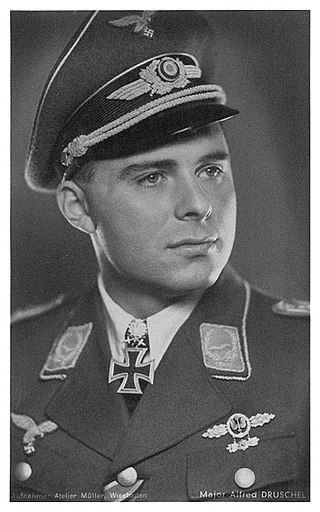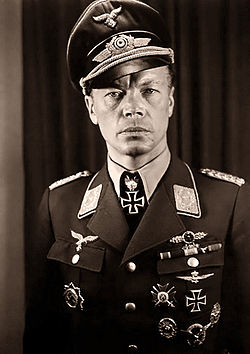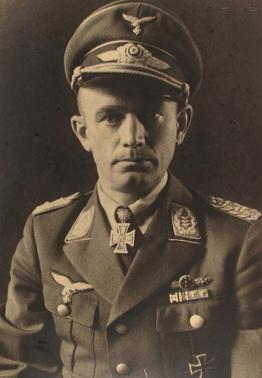
Alfred Druschel was a German Luftwaffe combat pilot during World War II. He was a recipient of the Knight's Cross of the Iron Cross with Oak Leaves and Swords of Nazi Germany.

Ernst Kupfer was a ground-attack pilot in the Luftwaffe of Nazi Germany during World War II who commanded a wing of Stuka aircraft. He was a recipient of the Knight's Cross of the Iron Cross with Oak Leaves and Swords.

Major Theodor Nordmann was a World War II Luftwaffe Stuka ace. He was also a recipient of the Knight's Cross of the Iron Cross with Oak Leaves and Swords. The Knight's Cross of the Iron Cross and its higher grade Oak Leaves and Swords was awarded to recognise extreme battlefield bravery or successful military leadership.

Ernst Gadermann was a German physician in the Wehrmacht of Nazi Germany during World War II. He was a recipient of the Knight's Cross of the Iron Cross. After World War II he became a well known cardiologist.

Franz Eisenach was a German fighter ace during World War II and a recipient of the Knight's Cross of the Iron Cross of Nazi Germany. He was credited with 129 aerial victories claimed in 319 combat missions, all on the Eastern front of the Second World War.

Hans-Karl Stepp was a German ground attack pilot and wing commander during World War II. He was a recipient of the Knight's Cross of the Iron Cross with Oak Leaves, a grade of the highest award in the military and paramilitary forces of Nazi Germany during World War II.

Oskar Dinort was a German general and ground attack aircraft pilot during World War II.

Alfred Bülowius was a German general during World War II. He was a recipient of the Knight's Cross of the Iron Cross of Nazi Germany.
Rudolf Schoenert was the seventh highest scoring night fighter flying ace in the German Luftwaffe during World War II. He was also a recipient of the Knight's Cross of the Iron Cross with Oak Leaves. The Knight's Cross of the Iron Cross and its higher grade Oak Leaves was awarded to recognise extreme battlefield bravery or successful military leadership.

Walter Adolf Christian Hagen was a pilot in the Luftwaffe during World War II and a recipient of the Knight's Cross of the Iron Cross with Oak Leaves of Nazi Germany.
Richard Leppla was a German fighter ace in the Luftwaffe during World War II. He was a recipient of the Knight's Cross of the Iron Cross. Leppla claimed 68 aerial victories claimed in over 500 combat missions. The Knight's Cross of the Iron Cross was awarded to recognise extreme battlefield bravery or successful military leadership.

Georg Dörffel was a highly decorated Oberstleutnant in the Luftwaffe during World War II, and one of only 882 recipients of the Knight's Cross of the Iron Cross with Oak Leaves. Georg Dörffel was killed on 26 May 1944, north of Rome. During his career he flew 1004 missions as a ground assault pilot. He was posthumously promoted to Oberstleutnant.
Karl Heinrich Höfer was a highly decorated Major in the Luftwaffe during World War II, and one of only 882 recipients of the Knight's Cross of the Iron Cross with Oak Leaves. The Knight's Cross of the Iron Cross and its higher grade Oak Leaves was awarded to recognise extreme battlefield bravery or successful military leadership.
Walter Sigel was a German air officer during World War II. He was a recipient of the Knight's Cross of the Iron Cross with Oak Leaves of Nazi Germany. He led the German bombers during the bombing of Wieluń, the first aerial bombing of the war. Sigel died on 8 May 1944 after crashing his aircraft into Trondheim Fjord.
Wilhelm Meyn was a general in the German Air Force. During World War II, he served in the Luftwaffe and was a recipient of the Knight's Cross of the Iron Cross of Nazi Germany. In 1956, he joined the Bundeswehr of West Germany and rose to the rank of Generalmajor, retiring in 1979.
Dr. Horst Patuschka was a Luftwaffe night fighter ace and recipient of the Knight's Cross of the Iron Cross during World War II. The Knight's Cross of the Iron Cross was awarded to recognise extreme battlefield bravery or successful military leadership. Horst Patuschka was killed on 6 March 1943 after his Junkers Ju 88 crashed near Bizerte, Tunisia due to engine failure. During his career he was credited with 23 aerial victories all of them at night. He was posthumously awarded the Knight's Cross on 10 May 1943.
Frank Neubert was a highly decorated Major in the Luftwaffe during World War II, and a recipient of the Knight's Cross of the Iron Cross. He is believed to have been the first victor in aerial combat in World War II after shooting down Captain Mieczyslaw Medwecki's PZL P.11 in the early hours of 1 September 1939. The Knight's Cross of the Iron Cross was awarded to recognise extreme battlefield bravery or successful military leadership. During his career he was credited with participating in 350+ missions.

Hans-Georg Schierholz was a Bordfunker and Oberfeldwebel in the Luftwaffe night fighter force during World War II. He was awarded the Knight's Cross of the Iron Cross.

Helmut Adalbert Mahlke was a highly decorated Oberstleutnant in the Luftwaffe during World War II, and a recipient of the Knight's Cross of the Iron Cross, the highest award in the military and paramilitary forces of Nazi Germany during World War II.
Clemens Graf von Schönborn-Wiesentheid was a German Air Force officer who commanded Air Command Arad and Sturzkampfgeschwader 77 during the Axis-led invasion of Yugoslavia during World War II. He was killed in a flying accident at Sofia, Bulgaria on 30 August 1944. He was planning to attend a General Staff meeting when his aircraft crashed for unknown reasons.











